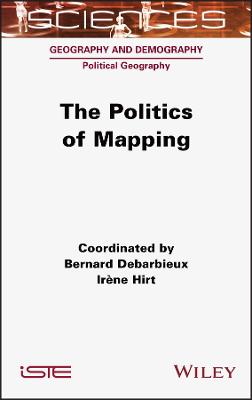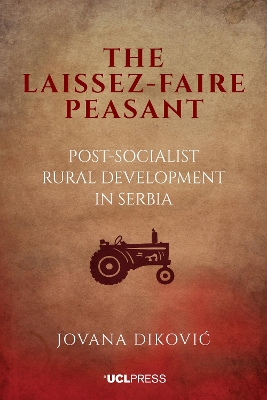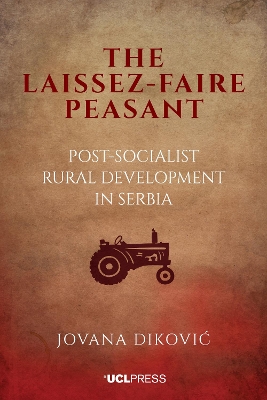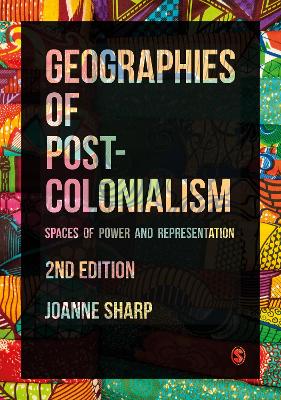Politics of Mapping
 portes grátis
portes grátis
Politics of Mapping
Debarbieux, Bernard; Hirt, Irene
ISTE Ltd
08/2022
288
Dura
Inglês
9781789450675
15 a 20 dias
512
Descrição não disponível.
Introduction xi
Bernard DEBARBIEUX and Irene HIRT
Chapter 1 The Map as a Legitimate Space: Cartography as a Language, a Stage and an Issue 1
Jacques LEVY
1.1 Introduction 1
1.2 Map truth regimes 3
1.3 The new spaces of the electoral map 6
1.4 Cartographic turn, geographic turn and political space 13
1.5 Ethical turn and mapping 16
1.6 Mapping, citizen science 18
1.7 References 22
Chapter 2 Cartography and Spatial Production of Society 25
Franco FARINELLI
2.1 The map, politics and morality 25
2.2 The map, territory and globe 28
2.3 The map, order and modernity 31
2.4 The map, reason and rhetoric. 35
2.5 The map, constraint and the self-organization. 39
2.6 The map, production and society 40
2.7 References 43
Chapter 3 Farewell to Maps: Reformulating Critical Cartography in the Digital Age 47
Pierre GAUTREAU and Matthieu NOUCHER
3.1 Introduction 47
3.2 Farewell to maps: when the digital world disrupts the objects and questions of a research current 48
3.2.1 The main issues of conventional critical mapping 48
3.2.2 What the digital world does to critical mapping: Russian doll-like difficulties 50
3.2.3 Methods maladapted to digital technology changes 54
3.3 The shortcomings of critical mapping exacerbated by digital technology 55
3.3.1 The "Harlesian" of reflections on the finished product 55
3.3.2 The taste for successful maps 56
3.3.3 A taste for great narratives 58
3.4 Reformulating critical mapping in the digital age 58
3.4.1 Three priority disciplinary alliances 59
3.4.2 Making political sense of what does not work: investigating "maps for nothing" in the digital age 60
3.4.3 The political meaning of cartographic modesty: what do the "small maps of the Web" tell us? 62
3.4.4 Circulation and policy 63
3.5 Conclusion 65
3.6 References 65
Chapter 4 Mapping and Participation in the topos and chora Test 69
Federica BURINI
4.1 Introduction 69
4.2 Participatory mapping tested by topos and chora 70
4.3 Toward a reflective approach to participatory mapping 71
4.4 From solicited mapping to collaborative systems and digital traces 72
4.5 The new boundaries of collaborative mapping systems produced by geolocation technologies 75
4.6 Representing the spatiotemporal dimension of urban mobility using data produced by inhabitants 76
4.7 Toward a reflective and chorographic approach to collaborative mapping systems 78
4.7.1 Solicited mapping systems with active participation 80
4.7.2 Voluntary and participatory mapping systems 83
4.7.3 Derivative and passive participatory map systems 85
4.8 Conclusion 86
4.9 References 87
Chapter 5 The Cartographic Factory of Modern States 91
Bernard DEBARBIEUX
5.1 Introduction 91
5.2 The invention of spatial modernity in the Renaissance 92
5.3 State imaginaries of space and territory 93
5.4 The construction of the nation-state through the map 103
5.5 The colonial adventure: a counter-illustration? 110
5.6 Maps and the government of things and people 113
5.7 Current state of the issue 118
5.8 References 119
Chapter 6 Statistical Cartography and International Governance in the Age of Big Data 127
Hy DAO
6.1 Introduction 127
6.2 Birth and internationalization of statistical cartography 128
6.3 International statistical mapping 129
6.3.1 Statistics and mapping by international organizations 129
6.3.2 Coordination of statistical and geographical information 132
6.3.3 Is the aggregation of national data outdated? 133
6.4 Cartography in the digital age 134
6.4.1 Computerization and dissemination of cartographic resources 134
6.4.2 A global information space based on the Web and Big Data 136
6.5 Mapping the SDGs 142
6.5.1 A set of non-binding targets for 2030 142
6.5.2 Governance of the SDG indicators 142
6.5.3 Information coverage of the SDGs 143
6.5.4 Cartographic visualizations of the SDGs 144
6.5.5 The SDG indicator process challenged by Big Data 146
6.6 (Re)configurations of international cartography 147
6.6.1 From the visual paradigm to the datamatic paradigm 147
6.6.2 Informational alignments 148
6.6.3 Political alignments 150
6.7 Conclusion 150
6.8 References 151
Chapter 7 Indigenous Mapping: Reclaiming Territories, Decolonizing Knowledge 155
Irene HIRT
7.1 Introduction 155
7.2 Conceptual and theoretical milestones 157
7.2.1 Indigenous counter-mapping: a struggle for concrete and symbolic spaces 157
7.2.2 Indigenous mapping as a field of academic thinking 161
7.3 Using maps to claim rights and reclaim territories 163
7.3.1 Brief history of the political use of maps 163
7.3.2 Indigenous mapping in the Americas: similarities and differences between North and South 164
7.3.3 The aporias of the "cartographic-legal strategy" 168
7.3.4 Controlling the flow of geographic information 170
7.3.5 The ambiguous role of the digital giants 171
7.4 Decolonizing maps and cartography 172
7.4.1 Toward an inclusive definition of maps 172
7.4.2 "Reconstructing" maps 174
7.4.3 Representing "Indigenous depth of place" 175
7.5 Conclusion 178
7.6 References 179
Chapter 8 Chorematic Representations in Participatory Processes of Territorial Projects 187
Sylvie LARDON
8.1 Introduction 187
8.2 Methodological choices 189
8.3 Three illustrations of the use of choremes in territorial projects 190
8.3.1 The Pikogan forest in Quebec or choremes for communicating 190
8.3.2 The Western Pacific Islands or the choremes for integrating the issues 192
8.3.3 The gardens of the Billom area in France or the choremes for acting 195
8.4 How can we evaluate this co-construction of territories? 197
8.5 References 199
Chapter 9 National Territorial Prospective Maps 201
Anne BAILLY
9.1 Introduction 201
9.2 DATAR, foresight and mapping 201
9.3 The Paris Basin White Paper 203
9.3.1 Cartographic design 205
9.3.2 The graphic vocabulary 205
9.3.3 Translating, visualizing and expressing intentions 206
9.4 The first maps of the great national debate on regional planning 207
9.5 France in 2015 210
9.6 France in 2020 212
9.6.1 Three "deterrent" scenarios 213
9.6.2 The "connected polycentrism" scenario 213
9.7 Lessons from a wealth of experience 215
9.8 References 215
Chapter 10 Making Maps to Fight Unjust Migration Policies 217
Olivier CLOCHARD
10.1 Introduction 217
10.2 Actors and objectives of cartographic productions 218
10.2.1 From respect to emancipation of semiological conventions 218
10.2.2 The two network compasses 223
10.3 Mapping experiments undertaken 225
10.3.1 Carrying knowledge and claims 225
10.3.2 New modes of representation 228
10.3.3 The words on the maps are also important 229
10.3.4 The issue of esthetics 232
10.4 Conclusion 234
10.5 References 234
List of Authors 237
Index 239
Bernard DEBARBIEUX and Irene HIRT
Chapter 1 The Map as a Legitimate Space: Cartography as a Language, a Stage and an Issue 1
Jacques LEVY
1.1 Introduction 1
1.2 Map truth regimes 3
1.3 The new spaces of the electoral map 6
1.4 Cartographic turn, geographic turn and political space 13
1.5 Ethical turn and mapping 16
1.6 Mapping, citizen science 18
1.7 References 22
Chapter 2 Cartography and Spatial Production of Society 25
Franco FARINELLI
2.1 The map, politics and morality 25
2.2 The map, territory and globe 28
2.3 The map, order and modernity 31
2.4 The map, reason and rhetoric. 35
2.5 The map, constraint and the self-organization. 39
2.6 The map, production and society 40
2.7 References 43
Chapter 3 Farewell to Maps: Reformulating Critical Cartography in the Digital Age 47
Pierre GAUTREAU and Matthieu NOUCHER
3.1 Introduction 47
3.2 Farewell to maps: when the digital world disrupts the objects and questions of a research current 48
3.2.1 The main issues of conventional critical mapping 48
3.2.2 What the digital world does to critical mapping: Russian doll-like difficulties 50
3.2.3 Methods maladapted to digital technology changes 54
3.3 The shortcomings of critical mapping exacerbated by digital technology 55
3.3.1 The "Harlesian" of reflections on the finished product 55
3.3.2 The taste for successful maps 56
3.3.3 A taste for great narratives 58
3.4 Reformulating critical mapping in the digital age 58
3.4.1 Three priority disciplinary alliances 59
3.4.2 Making political sense of what does not work: investigating "maps for nothing" in the digital age 60
3.4.3 The political meaning of cartographic modesty: what do the "small maps of the Web" tell us? 62
3.4.4 Circulation and policy 63
3.5 Conclusion 65
3.6 References 65
Chapter 4 Mapping and Participation in the topos and chora Test 69
Federica BURINI
4.1 Introduction 69
4.2 Participatory mapping tested by topos and chora 70
4.3 Toward a reflective approach to participatory mapping 71
4.4 From solicited mapping to collaborative systems and digital traces 72
4.5 The new boundaries of collaborative mapping systems produced by geolocation technologies 75
4.6 Representing the spatiotemporal dimension of urban mobility using data produced by inhabitants 76
4.7 Toward a reflective and chorographic approach to collaborative mapping systems 78
4.7.1 Solicited mapping systems with active participation 80
4.7.2 Voluntary and participatory mapping systems 83
4.7.3 Derivative and passive participatory map systems 85
4.8 Conclusion 86
4.9 References 87
Chapter 5 The Cartographic Factory of Modern States 91
Bernard DEBARBIEUX
5.1 Introduction 91
5.2 The invention of spatial modernity in the Renaissance 92
5.3 State imaginaries of space and territory 93
5.4 The construction of the nation-state through the map 103
5.5 The colonial adventure: a counter-illustration? 110
5.6 Maps and the government of things and people 113
5.7 Current state of the issue 118
5.8 References 119
Chapter 6 Statistical Cartography and International Governance in the Age of Big Data 127
Hy DAO
6.1 Introduction 127
6.2 Birth and internationalization of statistical cartography 128
6.3 International statistical mapping 129
6.3.1 Statistics and mapping by international organizations 129
6.3.2 Coordination of statistical and geographical information 132
6.3.3 Is the aggregation of national data outdated? 133
6.4 Cartography in the digital age 134
6.4.1 Computerization and dissemination of cartographic resources 134
6.4.2 A global information space based on the Web and Big Data 136
6.5 Mapping the SDGs 142
6.5.1 A set of non-binding targets for 2030 142
6.5.2 Governance of the SDG indicators 142
6.5.3 Information coverage of the SDGs 143
6.5.4 Cartographic visualizations of the SDGs 144
6.5.5 The SDG indicator process challenged by Big Data 146
6.6 (Re)configurations of international cartography 147
6.6.1 From the visual paradigm to the datamatic paradigm 147
6.6.2 Informational alignments 148
6.6.3 Political alignments 150
6.7 Conclusion 150
6.8 References 151
Chapter 7 Indigenous Mapping: Reclaiming Territories, Decolonizing Knowledge 155
Irene HIRT
7.1 Introduction 155
7.2 Conceptual and theoretical milestones 157
7.2.1 Indigenous counter-mapping: a struggle for concrete and symbolic spaces 157
7.2.2 Indigenous mapping as a field of academic thinking 161
7.3 Using maps to claim rights and reclaim territories 163
7.3.1 Brief history of the political use of maps 163
7.3.2 Indigenous mapping in the Americas: similarities and differences between North and South 164
7.3.3 The aporias of the "cartographic-legal strategy" 168
7.3.4 Controlling the flow of geographic information 170
7.3.5 The ambiguous role of the digital giants 171
7.4 Decolonizing maps and cartography 172
7.4.1 Toward an inclusive definition of maps 172
7.4.2 "Reconstructing" maps 174
7.4.3 Representing "Indigenous depth of place" 175
7.5 Conclusion 178
7.6 References 179
Chapter 8 Chorematic Representations in Participatory Processes of Territorial Projects 187
Sylvie LARDON
8.1 Introduction 187
8.2 Methodological choices 189
8.3 Three illustrations of the use of choremes in territorial projects 190
8.3.1 The Pikogan forest in Quebec or choremes for communicating 190
8.3.2 The Western Pacific Islands or the choremes for integrating the issues 192
8.3.3 The gardens of the Billom area in France or the choremes for acting 195
8.4 How can we evaluate this co-construction of territories? 197
8.5 References 199
Chapter 9 National Territorial Prospective Maps 201
Anne BAILLY
9.1 Introduction 201
9.2 DATAR, foresight and mapping 201
9.3 The Paris Basin White Paper 203
9.3.1 Cartographic design 205
9.3.2 The graphic vocabulary 205
9.3.3 Translating, visualizing and expressing intentions 206
9.4 The first maps of the great national debate on regional planning 207
9.5 France in 2015 210
9.6 France in 2020 212
9.6.1 Three "deterrent" scenarios 213
9.6.2 The "connected polycentrism" scenario 213
9.7 Lessons from a wealth of experience 215
9.8 References 215
Chapter 10 Making Maps to Fight Unjust Migration Policies 217
Olivier CLOCHARD
10.1 Introduction 217
10.2 Actors and objectives of cartographic productions 218
10.2.1 From respect to emancipation of semiological conventions 218
10.2.2 The two network compasses 223
10.3 Mapping experiments undertaken 225
10.3.1 Carrying knowledge and claims 225
10.3.2 New modes of representation 228
10.3.3 The words on the maps are also important 229
10.3.4 The issue of esthetics 232
10.4 Conclusion 234
10.5 References 234
List of Authors 237
Index 239
Este título pertence ao(s) assunto(s) indicados(s). Para ver outros títulos clique no assunto desejado.
mapping; geography; mapping politics; politics; geo
Introduction xi
Bernard DEBARBIEUX and Irene HIRT
Chapter 1 The Map as a Legitimate Space: Cartography as a Language, a Stage and an Issue 1
Jacques LEVY
1.1 Introduction 1
1.2 Map truth regimes 3
1.3 The new spaces of the electoral map 6
1.4 Cartographic turn, geographic turn and political space 13
1.5 Ethical turn and mapping 16
1.6 Mapping, citizen science 18
1.7 References 22
Chapter 2 Cartography and Spatial Production of Society 25
Franco FARINELLI
2.1 The map, politics and morality 25
2.2 The map, territory and globe 28
2.3 The map, order and modernity 31
2.4 The map, reason and rhetoric. 35
2.5 The map, constraint and the self-organization. 39
2.6 The map, production and society 40
2.7 References 43
Chapter 3 Farewell to Maps: Reformulating Critical Cartography in the Digital Age 47
Pierre GAUTREAU and Matthieu NOUCHER
3.1 Introduction 47
3.2 Farewell to maps: when the digital world disrupts the objects and questions of a research current 48
3.2.1 The main issues of conventional critical mapping 48
3.2.2 What the digital world does to critical mapping: Russian doll-like difficulties 50
3.2.3 Methods maladapted to digital technology changes 54
3.3 The shortcomings of critical mapping exacerbated by digital technology 55
3.3.1 The "Harlesian" of reflections on the finished product 55
3.3.2 The taste for successful maps 56
3.3.3 A taste for great narratives 58
3.4 Reformulating critical mapping in the digital age 58
3.4.1 Three priority disciplinary alliances 59
3.4.2 Making political sense of what does not work: investigating "maps for nothing" in the digital age 60
3.4.3 The political meaning of cartographic modesty: what do the "small maps of the Web" tell us? 62
3.4.4 Circulation and policy 63
3.5 Conclusion 65
3.6 References 65
Chapter 4 Mapping and Participation in the topos and chora Test 69
Federica BURINI
4.1 Introduction 69
4.2 Participatory mapping tested by topos and chora 70
4.3 Toward a reflective approach to participatory mapping 71
4.4 From solicited mapping to collaborative systems and digital traces 72
4.5 The new boundaries of collaborative mapping systems produced by geolocation technologies 75
4.6 Representing the spatiotemporal dimension of urban mobility using data produced by inhabitants 76
4.7 Toward a reflective and chorographic approach to collaborative mapping systems 78
4.7.1 Solicited mapping systems with active participation 80
4.7.2 Voluntary and participatory mapping systems 83
4.7.3 Derivative and passive participatory map systems 85
4.8 Conclusion 86
4.9 References 87
Chapter 5 The Cartographic Factory of Modern States 91
Bernard DEBARBIEUX
5.1 Introduction 91
5.2 The invention of spatial modernity in the Renaissance 92
5.3 State imaginaries of space and territory 93
5.4 The construction of the nation-state through the map 103
5.5 The colonial adventure: a counter-illustration? 110
5.6 Maps and the government of things and people 113
5.7 Current state of the issue 118
5.8 References 119
Chapter 6 Statistical Cartography and International Governance in the Age of Big Data 127
Hy DAO
6.1 Introduction 127
6.2 Birth and internationalization of statistical cartography 128
6.3 International statistical mapping 129
6.3.1 Statistics and mapping by international organizations 129
6.3.2 Coordination of statistical and geographical information 132
6.3.3 Is the aggregation of national data outdated? 133
6.4 Cartography in the digital age 134
6.4.1 Computerization and dissemination of cartographic resources 134
6.4.2 A global information space based on the Web and Big Data 136
6.5 Mapping the SDGs 142
6.5.1 A set of non-binding targets for 2030 142
6.5.2 Governance of the SDG indicators 142
6.5.3 Information coverage of the SDGs 143
6.5.4 Cartographic visualizations of the SDGs 144
6.5.5 The SDG indicator process challenged by Big Data 146
6.6 (Re)configurations of international cartography 147
6.6.1 From the visual paradigm to the datamatic paradigm 147
6.6.2 Informational alignments 148
6.6.3 Political alignments 150
6.7 Conclusion 150
6.8 References 151
Chapter 7 Indigenous Mapping: Reclaiming Territories, Decolonizing Knowledge 155
Irene HIRT
7.1 Introduction 155
7.2 Conceptual and theoretical milestones 157
7.2.1 Indigenous counter-mapping: a struggle for concrete and symbolic spaces 157
7.2.2 Indigenous mapping as a field of academic thinking 161
7.3 Using maps to claim rights and reclaim territories 163
7.3.1 Brief history of the political use of maps 163
7.3.2 Indigenous mapping in the Americas: similarities and differences between North and South 164
7.3.3 The aporias of the "cartographic-legal strategy" 168
7.3.4 Controlling the flow of geographic information 170
7.3.5 The ambiguous role of the digital giants 171
7.4 Decolonizing maps and cartography 172
7.4.1 Toward an inclusive definition of maps 172
7.4.2 "Reconstructing" maps 174
7.4.3 Representing "Indigenous depth of place" 175
7.5 Conclusion 178
7.6 References 179
Chapter 8 Chorematic Representations in Participatory Processes of Territorial Projects 187
Sylvie LARDON
8.1 Introduction 187
8.2 Methodological choices 189
8.3 Three illustrations of the use of choremes in territorial projects 190
8.3.1 The Pikogan forest in Quebec or choremes for communicating 190
8.3.2 The Western Pacific Islands or the choremes for integrating the issues 192
8.3.3 The gardens of the Billom area in France or the choremes for acting 195
8.4 How can we evaluate this co-construction of territories? 197
8.5 References 199
Chapter 9 National Territorial Prospective Maps 201
Anne BAILLY
9.1 Introduction 201
9.2 DATAR, foresight and mapping 201
9.3 The Paris Basin White Paper 203
9.3.1 Cartographic design 205
9.3.2 The graphic vocabulary 205
9.3.3 Translating, visualizing and expressing intentions 206
9.4 The first maps of the great national debate on regional planning 207
9.5 France in 2015 210
9.6 France in 2020 212
9.6.1 Three "deterrent" scenarios 213
9.6.2 The "connected polycentrism" scenario 213
9.7 Lessons from a wealth of experience 215
9.8 References 215
Chapter 10 Making Maps to Fight Unjust Migration Policies 217
Olivier CLOCHARD
10.1 Introduction 217
10.2 Actors and objectives of cartographic productions 218
10.2.1 From respect to emancipation of semiological conventions 218
10.2.2 The two network compasses 223
10.3 Mapping experiments undertaken 225
10.3.1 Carrying knowledge and claims 225
10.3.2 New modes of representation 228
10.3.3 The words on the maps are also important 229
10.3.4 The issue of esthetics 232
10.4 Conclusion 234
10.5 References 234
List of Authors 237
Index 239
Bernard DEBARBIEUX and Irene HIRT
Chapter 1 The Map as a Legitimate Space: Cartography as a Language, a Stage and an Issue 1
Jacques LEVY
1.1 Introduction 1
1.2 Map truth regimes 3
1.3 The new spaces of the electoral map 6
1.4 Cartographic turn, geographic turn and political space 13
1.5 Ethical turn and mapping 16
1.6 Mapping, citizen science 18
1.7 References 22
Chapter 2 Cartography and Spatial Production of Society 25
Franco FARINELLI
2.1 The map, politics and morality 25
2.2 The map, territory and globe 28
2.3 The map, order and modernity 31
2.4 The map, reason and rhetoric. 35
2.5 The map, constraint and the self-organization. 39
2.6 The map, production and society 40
2.7 References 43
Chapter 3 Farewell to Maps: Reformulating Critical Cartography in the Digital Age 47
Pierre GAUTREAU and Matthieu NOUCHER
3.1 Introduction 47
3.2 Farewell to maps: when the digital world disrupts the objects and questions of a research current 48
3.2.1 The main issues of conventional critical mapping 48
3.2.2 What the digital world does to critical mapping: Russian doll-like difficulties 50
3.2.3 Methods maladapted to digital technology changes 54
3.3 The shortcomings of critical mapping exacerbated by digital technology 55
3.3.1 The "Harlesian" of reflections on the finished product 55
3.3.2 The taste for successful maps 56
3.3.3 A taste for great narratives 58
3.4 Reformulating critical mapping in the digital age 58
3.4.1 Three priority disciplinary alliances 59
3.4.2 Making political sense of what does not work: investigating "maps for nothing" in the digital age 60
3.4.3 The political meaning of cartographic modesty: what do the "small maps of the Web" tell us? 62
3.4.4 Circulation and policy 63
3.5 Conclusion 65
3.6 References 65
Chapter 4 Mapping and Participation in the topos and chora Test 69
Federica BURINI
4.1 Introduction 69
4.2 Participatory mapping tested by topos and chora 70
4.3 Toward a reflective approach to participatory mapping 71
4.4 From solicited mapping to collaborative systems and digital traces 72
4.5 The new boundaries of collaborative mapping systems produced by geolocation technologies 75
4.6 Representing the spatiotemporal dimension of urban mobility using data produced by inhabitants 76
4.7 Toward a reflective and chorographic approach to collaborative mapping systems 78
4.7.1 Solicited mapping systems with active participation 80
4.7.2 Voluntary and participatory mapping systems 83
4.7.3 Derivative and passive participatory map systems 85
4.8 Conclusion 86
4.9 References 87
Chapter 5 The Cartographic Factory of Modern States 91
Bernard DEBARBIEUX
5.1 Introduction 91
5.2 The invention of spatial modernity in the Renaissance 92
5.3 State imaginaries of space and territory 93
5.4 The construction of the nation-state through the map 103
5.5 The colonial adventure: a counter-illustration? 110
5.6 Maps and the government of things and people 113
5.7 Current state of the issue 118
5.8 References 119
Chapter 6 Statistical Cartography and International Governance in the Age of Big Data 127
Hy DAO
6.1 Introduction 127
6.2 Birth and internationalization of statistical cartography 128
6.3 International statistical mapping 129
6.3.1 Statistics and mapping by international organizations 129
6.3.2 Coordination of statistical and geographical information 132
6.3.3 Is the aggregation of national data outdated? 133
6.4 Cartography in the digital age 134
6.4.1 Computerization and dissemination of cartographic resources 134
6.4.2 A global information space based on the Web and Big Data 136
6.5 Mapping the SDGs 142
6.5.1 A set of non-binding targets for 2030 142
6.5.2 Governance of the SDG indicators 142
6.5.3 Information coverage of the SDGs 143
6.5.4 Cartographic visualizations of the SDGs 144
6.5.5 The SDG indicator process challenged by Big Data 146
6.6 (Re)configurations of international cartography 147
6.6.1 From the visual paradigm to the datamatic paradigm 147
6.6.2 Informational alignments 148
6.6.3 Political alignments 150
6.7 Conclusion 150
6.8 References 151
Chapter 7 Indigenous Mapping: Reclaiming Territories, Decolonizing Knowledge 155
Irene HIRT
7.1 Introduction 155
7.2 Conceptual and theoretical milestones 157
7.2.1 Indigenous counter-mapping: a struggle for concrete and symbolic spaces 157
7.2.2 Indigenous mapping as a field of academic thinking 161
7.3 Using maps to claim rights and reclaim territories 163
7.3.1 Brief history of the political use of maps 163
7.3.2 Indigenous mapping in the Americas: similarities and differences between North and South 164
7.3.3 The aporias of the "cartographic-legal strategy" 168
7.3.4 Controlling the flow of geographic information 170
7.3.5 The ambiguous role of the digital giants 171
7.4 Decolonizing maps and cartography 172
7.4.1 Toward an inclusive definition of maps 172
7.4.2 "Reconstructing" maps 174
7.4.3 Representing "Indigenous depth of place" 175
7.5 Conclusion 178
7.6 References 179
Chapter 8 Chorematic Representations in Participatory Processes of Territorial Projects 187
Sylvie LARDON
8.1 Introduction 187
8.2 Methodological choices 189
8.3 Three illustrations of the use of choremes in territorial projects 190
8.3.1 The Pikogan forest in Quebec or choremes for communicating 190
8.3.2 The Western Pacific Islands or the choremes for integrating the issues 192
8.3.3 The gardens of the Billom area in France or the choremes for acting 195
8.4 How can we evaluate this co-construction of territories? 197
8.5 References 199
Chapter 9 National Territorial Prospective Maps 201
Anne BAILLY
9.1 Introduction 201
9.2 DATAR, foresight and mapping 201
9.3 The Paris Basin White Paper 203
9.3.1 Cartographic design 205
9.3.2 The graphic vocabulary 205
9.3.3 Translating, visualizing and expressing intentions 206
9.4 The first maps of the great national debate on regional planning 207
9.5 France in 2015 210
9.6 France in 2020 212
9.6.1 Three "deterrent" scenarios 213
9.6.2 The "connected polycentrism" scenario 213
9.7 Lessons from a wealth of experience 215
9.8 References 215
Chapter 10 Making Maps to Fight Unjust Migration Policies 217
Olivier CLOCHARD
10.1 Introduction 217
10.2 Actors and objectives of cartographic productions 218
10.2.1 From respect to emancipation of semiological conventions 218
10.2.2 The two network compasses 223
10.3 Mapping experiments undertaken 225
10.3.1 Carrying knowledge and claims 225
10.3.2 New modes of representation 228
10.3.3 The words on the maps are also important 229
10.3.4 The issue of esthetics 232
10.4 Conclusion 234
10.5 References 234
List of Authors 237
Index 239
Este título pertence ao(s) assunto(s) indicados(s). Para ver outros títulos clique no assunto desejado.







